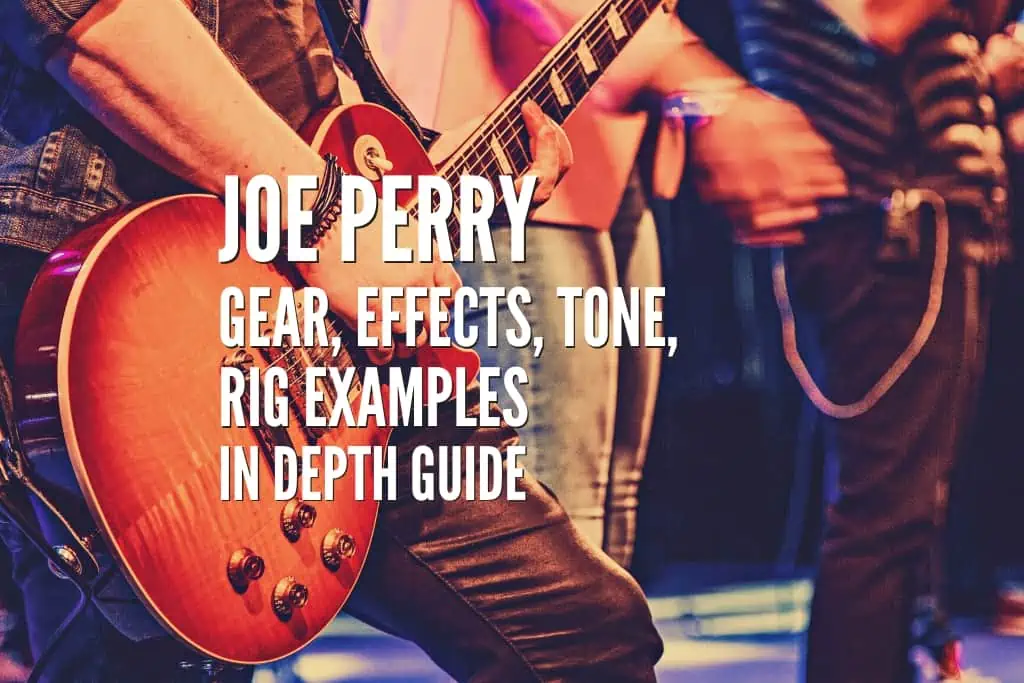When talking about legendary guitar tones, Joe Perry of Aerosmith is an iconic name that deserves great attention. His perfect classic rock and roll tone, along with his unique guitars and constantly-changing gear, create one of the most recognizable guitar tones ever in rock history.
Whether in the studio or on the stage, Joe Perry’s tone is highly recognizable as he has not changed his sound much since his first day in the music industry. From his iconic Big Muff tones to his modulation pedals and his iconic Les Pauls, he experimented with a lot of gear but succeeded in preserving his tone as it is.
Not only his gear and tones are unique, but also his way of playing the guitar is also pretty different. From his smoothed-out rhythm playing in songs like Dream On to his lead licks in tunes like Walk This Way, he is a highly versatile guitarist that shows the audience something new each time. He likes to use vintage guitars and gear that are quite hard to find, as he is highly interested in different guitars, pedals, amps, and everything. That is how he creates the signature Aerosmith sound that fans are in love with.
So, today I will give you a brief history of the gear and effects of Joe Perry before talking about how to get close to his iconic tones. Let’s go!
Guitars
Signature Guitars
1996 Gibson Custom Shop Joe Perry Les Paul
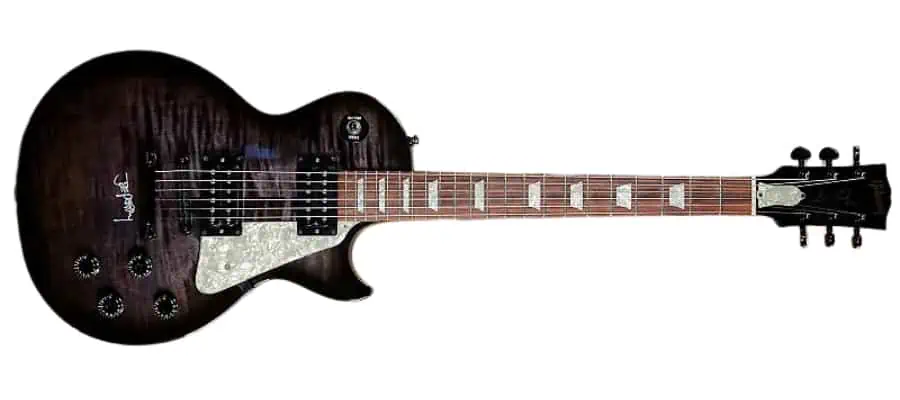

When talking about Joe Perry’s guitars, the first one to come to mind is, without a doubt, his custom Les Paul guitars. This one is called the 1996 Gibson Custom Shop Joe Perry Les Paul, one of his most-used guitars ever. It is his first ever Les Paul guitar. It has a black-gray striped body with dual humbuckers.
Gibson Custom Joe Perry Boneyard Les Paul Electric Guitar
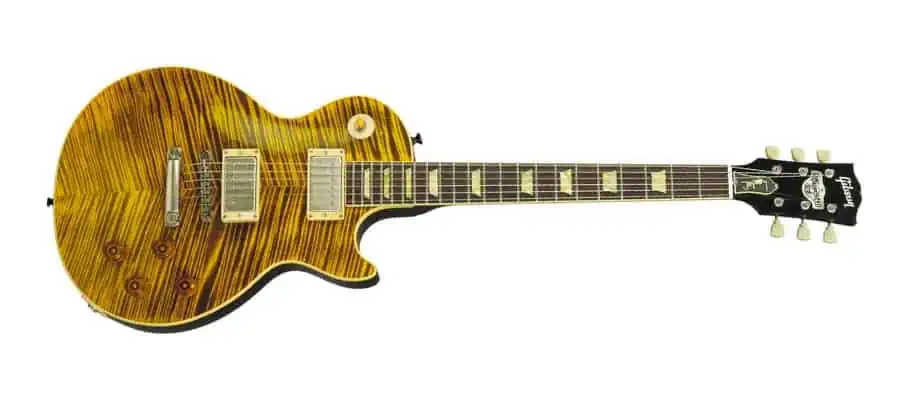

Joe Perry’s second Les Paul is the Gibson Custom Joe Perry Boneyard Les Paul Electric Guitar, which has a gold top with a very 50’s neck like a baseball bat. Perry likes big fat necks and the dual humbucker design. The pickups are wired at a phase, making it a very unique-sounding guitar. Perry uses this one also pretty often on the stage.
Gibson Joe Perry Axcess Les Paul
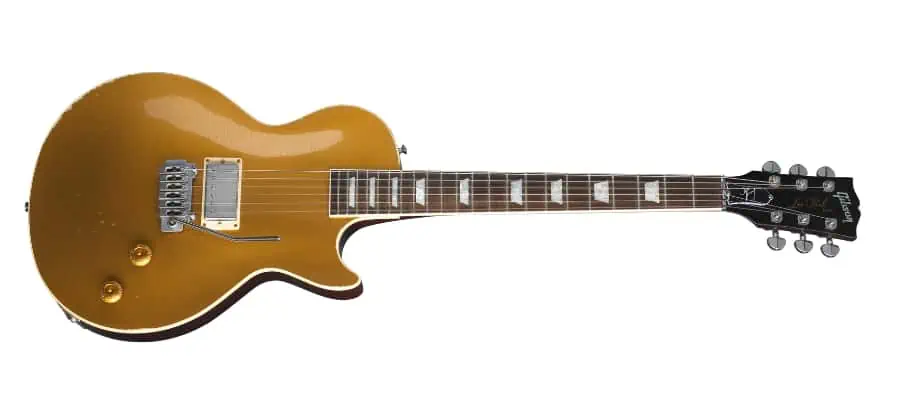

Joe Perry’s Les Paul number 3 is another great Les Paul that is lighter than the other Les Paul models. It has an Axcess body and sounds pretty amazing. It has a Wilkinson Tremolo and is not a production model for now. Joe Perry said that he likes to play with this Les Paul as he has used it very often in recent years.
Electric Guitars
Ampeg Dan Armstrong Plexi Electric Guitar


Ampeg Dan Armstrong Plexi Electric Guitar is one of the first guitars Joe Perry used with Aerosmith. He changed the pickups with custom-made ones, and he has a few of these guitars that are identical to each other. He uses this guitar in the open-A tuning for Keith Richards-style open-A five-string chords. He also puts a bass string on the bottom to give the guitar a growl. He uses the instrument for songs like Draw The Line.
B.C. Rich Perfect 10 Bich 10-String Guitar
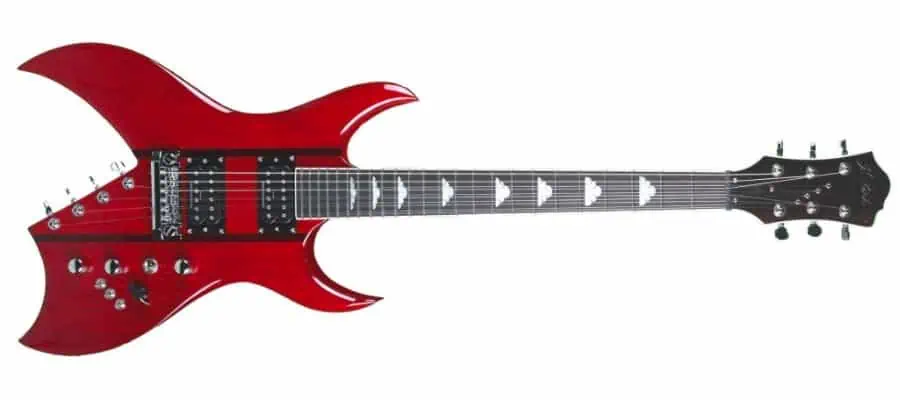

One of the guitars heavily associated with Joe Perry is this B.C. Rich Perfect 10 Bich 10-String Guitar. It has 10 strings, and the D, G, B, and the high E are all in unison. And the strings all have different gauges to create different sounds and more clarity. Perry uses this guitar in the song Living On The Edge.
Fender Custom Telecaster Electric Guitar
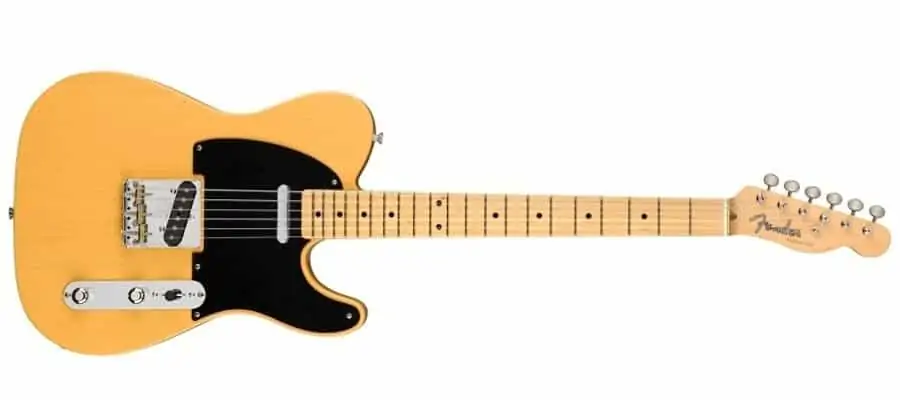

Another guitar Perry uses often is his Fender Custom Telecaster Electric Guitar. He plays it in songs like No More No More, and the guitar is all tuned in Es and Bs. He plays this guitar for the intro and changes it when the lead guitar parts come. The guitar has an old Gretsch pickup on it.
Echopark Blue Rose
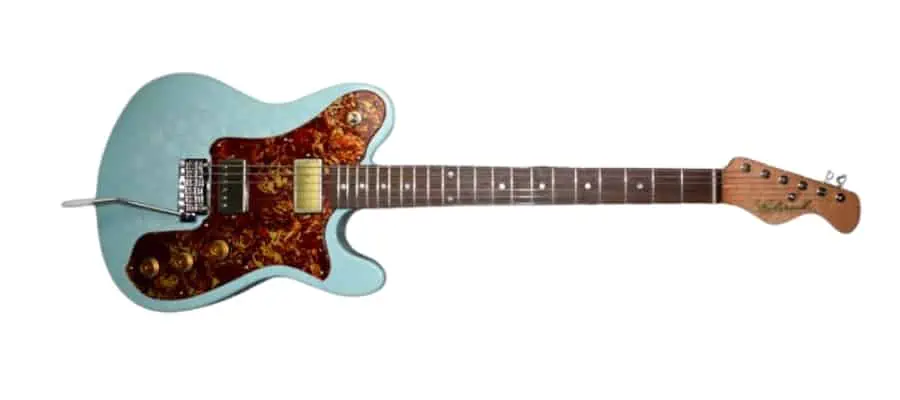

Echopark Blue Rose is a custom-made guitar from the famous Echopark Guitars. It is a hollow guitar, which was later filled to avoid feedback. Perry uses it more often on the recordings and sometimes in live performances.
Fender Standard Stratocaster


While touring in the mid-90s, Joe Perry often used the traditional Fender Standard Stratocasters. He has many different Strats, even a left-handed one that he plays from time to time. All his Strats have little nuances like different pickups, colors, or the tremolo system.
Fender Jeff Beck Tribute Esquire Electric Guitar
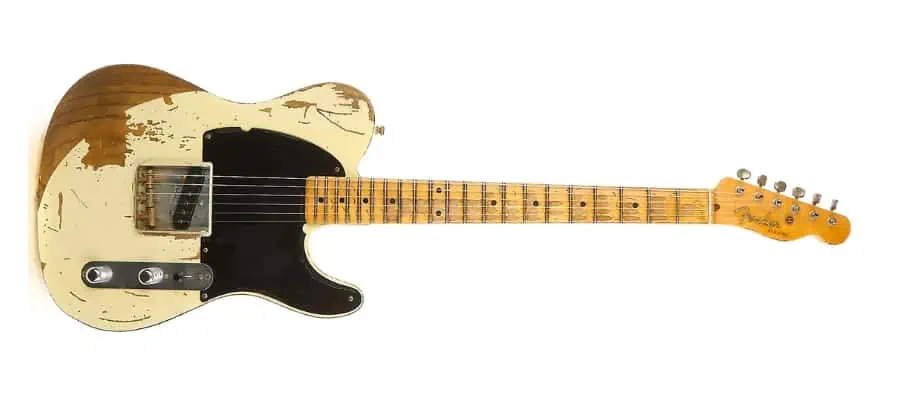

As Perry likes vintage instruments, he has the iconic Jeff Beck Esquire, the closest guitar you can find to Jeff Beck’s exact Esquire. It sounds pretty impressive, and Joe Perry uses it for songs like Chip Away the Stone and Last Child.
Gibson B.B. King Lucille Semi-Hollow Guitar
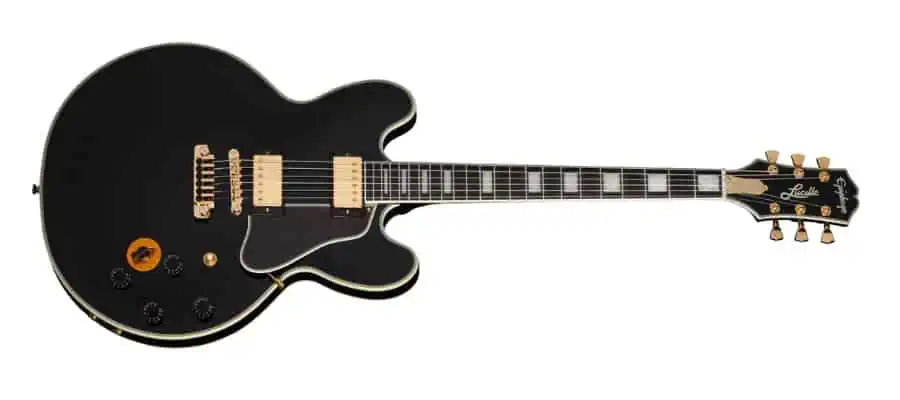

Gibson B.B. King Lucille Semi-Hollow Guitar is another interesting guitar Perry loves. It comes without F holes, and it is missing two tone and volume knobs. It is a custom-made guitar for Joe Perry, and the guitar looks amazingly cool with the woman sketch on the top and the back.
Echopark Ghetto Bird
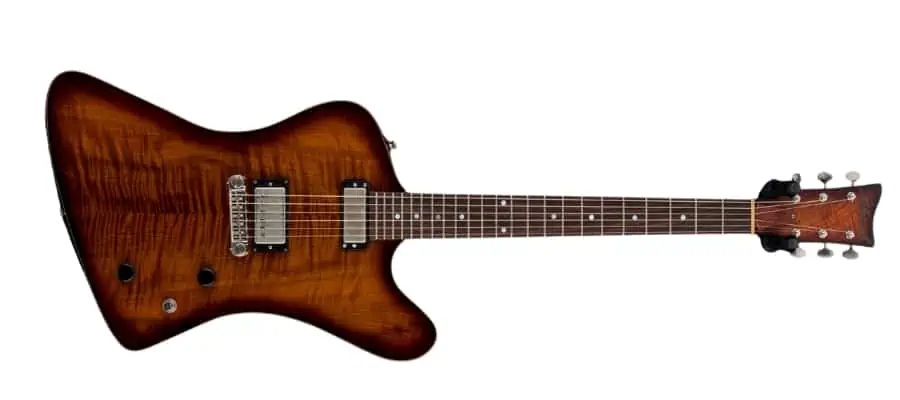

Joe Perry’s other Echopark guitar, Echopark Ghetto Bird, is a pretty chunky guitar. It features a quite large neck and has P90 and a humbucker on it. It has a volume and a tone knob, which is unusual for Perry as he removes the tone knobs on his guitars.
Bass Guitars
Ernie Ball Music Man Silhouette 6-String Bass
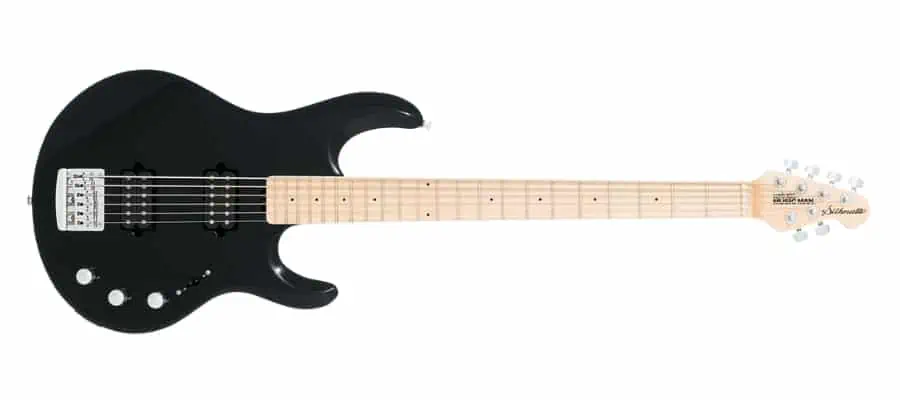

Joe Perry uses an Ernie Ball Music Man Silhouette 6-String Bass for the song Back on the Saddle. Actually, he wrote and recorded the song with a Fender, but that guitar was stolen many years ago. The guitar is tuned to G and sounds pretty growly. The string gauge on the guitar is .045 to .105.
Fender Bass VI
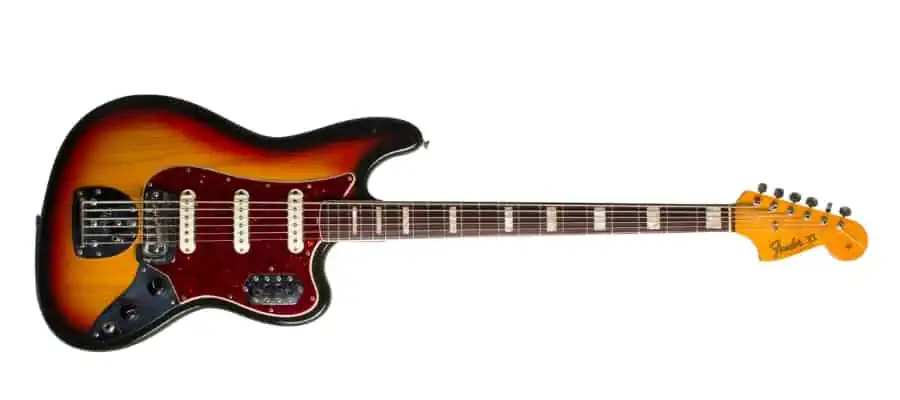

Fender Bass VI was the guitar with which the album, Back On The Saddle was recorded. Perry used it at the time on the stage, too, but the guitar was stolen a few years later, and Peryy replaced it with an Ernie Ball Music Man Silhouette 6-String Bass.
Other Guitars
Chandler RH-2 Lap Steel Guitar
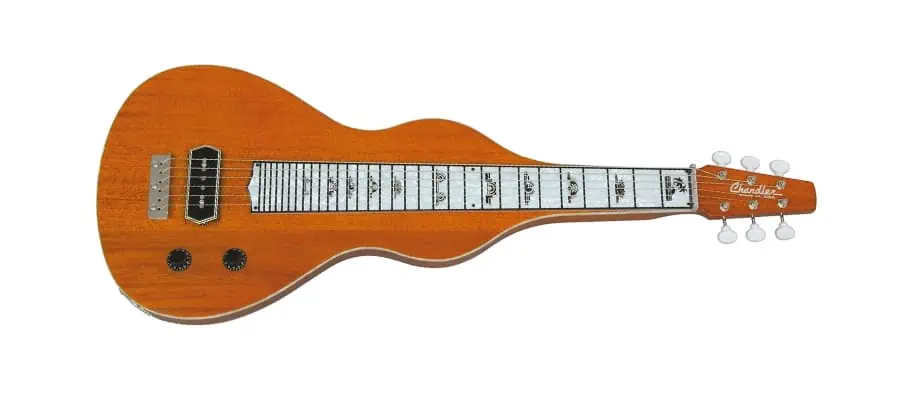

Chandler RH-2 Lap Steel Guitar, or the so-called Rag Doll guitar, is the lap steel guitar Perry uses for the song Rag Doll. It is tuned to the E chord. Perry plays slide guitar on this one. It has twelve string sets and thirteen string sets on the bottom.
Guitar Pickups
Seymour Duncan JB Jr. SJBJ-1
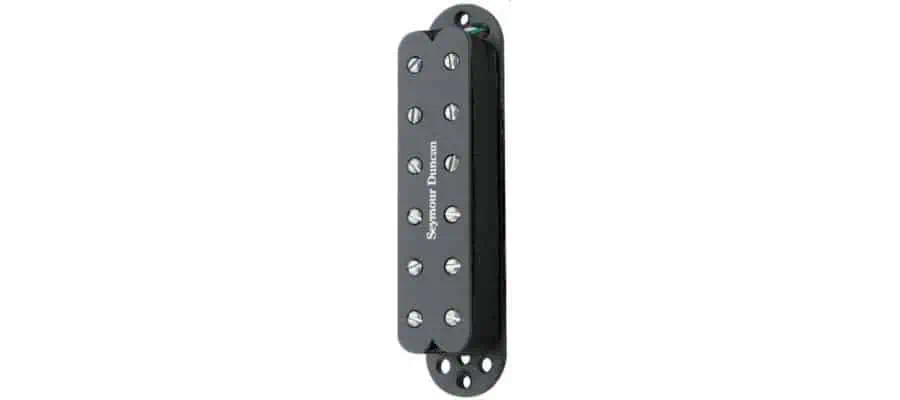
One of the pickups Joe Perry frequently uses on his guitars is the Seymour Duncan JB Jr. SJBJ-1, according to the official webpage of Seymour Duncan.
Guitar Strings
Ernie Ball Skinny Top Heavy Bottom M-Steel Slinky
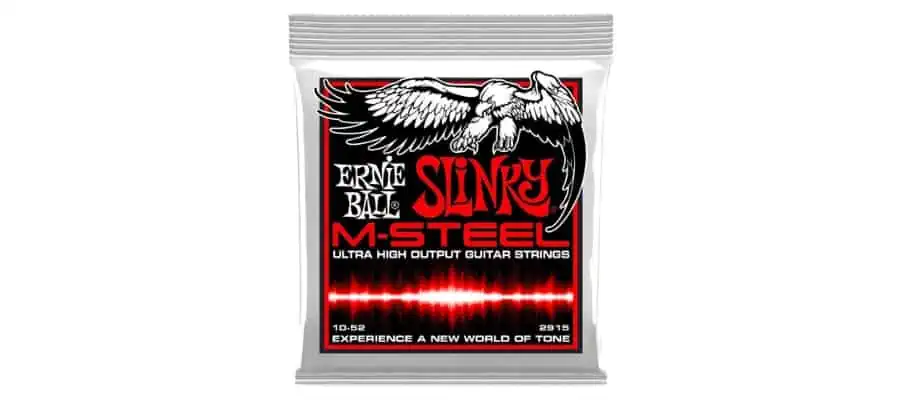
Joe Perry prefers the Ernie Ball Skinny Top Heavy Bottom M-Steel Slinky strings on his guitars. The string gauge is 10 to 52.
Ernie Ball RPS Super Slinky Guitar Strings (9-42)

When Perry wants thinner strings, he goes for Ernie Ball RPS Super Slinky Guitar Strings. The string gauge is 9 to 42.
Ernie Ball Hybrid Slinky Bass Strings (45-105)
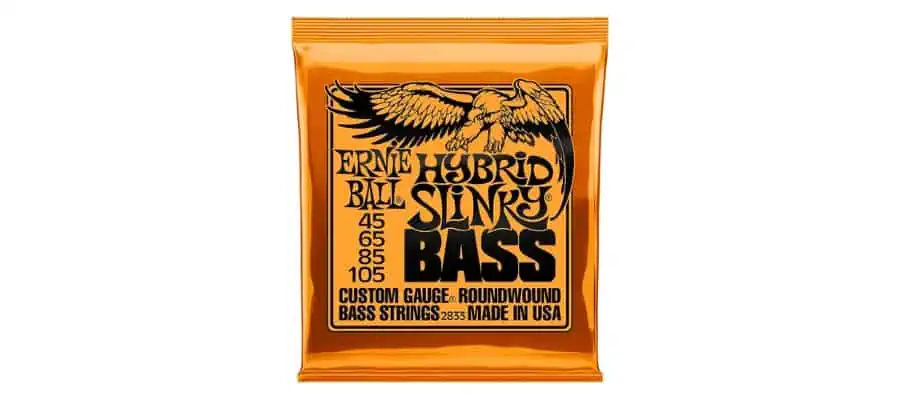
Perry goes with Ernie Ball Hybrid Slinky Bass Strings with string gauges 45 to 105 for the bass guitars.
Amps
Vox AC15
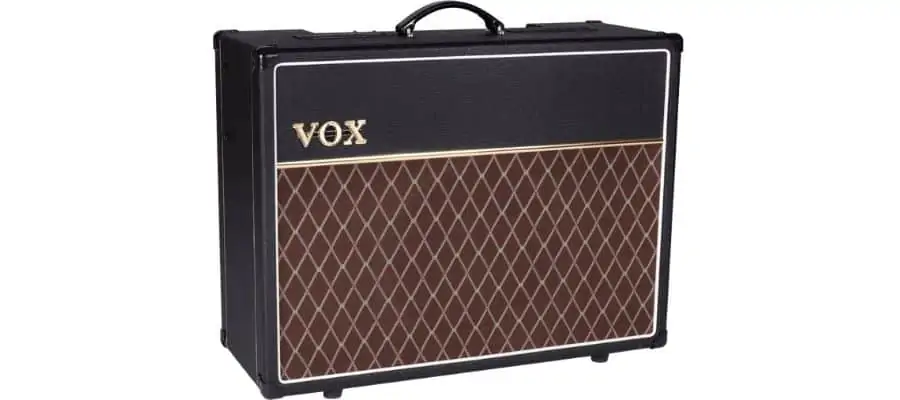
According to his interview, Joe Perry has a Vox AC15 in his studio that he likes to jam, compose, and record with.
Friedman Dirty Shirley 40 40-watt Tube Head
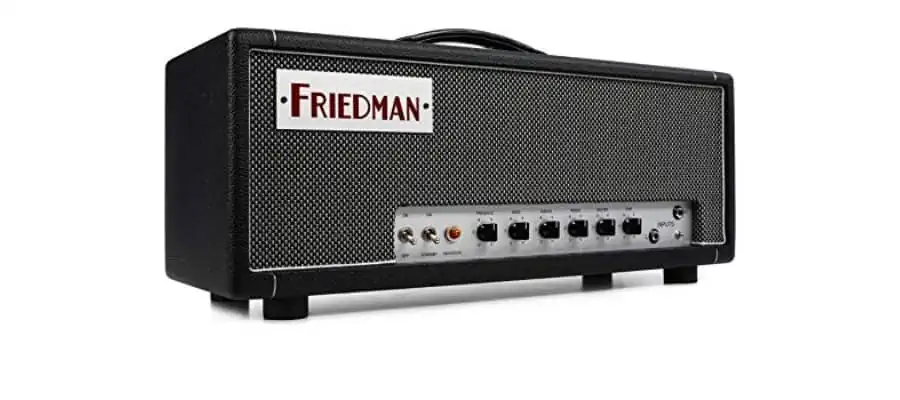

On the stage, Joe Perry uses a Friedman Dirty Shirley 40 40-watt Tube Head connected to a 15-cab. He likes the drive ranges of the amp, as it sounds pretty warm.
Fender Tweed Champ
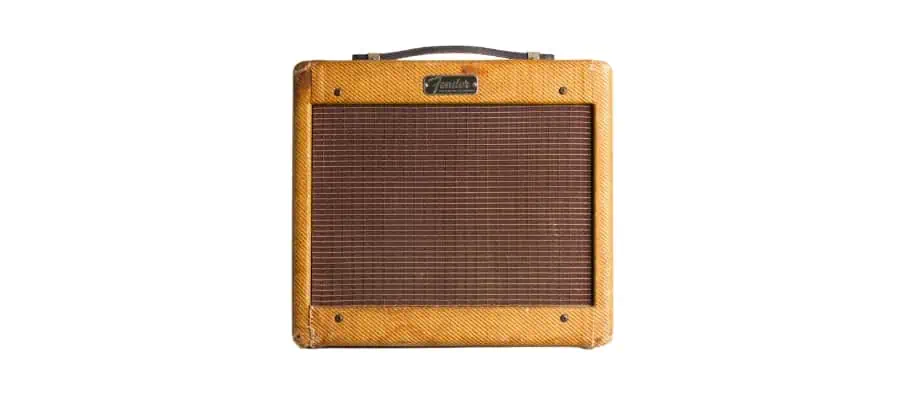
For the Honkin’ On Bobo recordings, Perry used a Fender Tweed Champ. He combined it with a small Epiphone 8-inch speaker practice amp.
Jet City Amplification JCA20H 20W Tube Guitar Amplifier Head
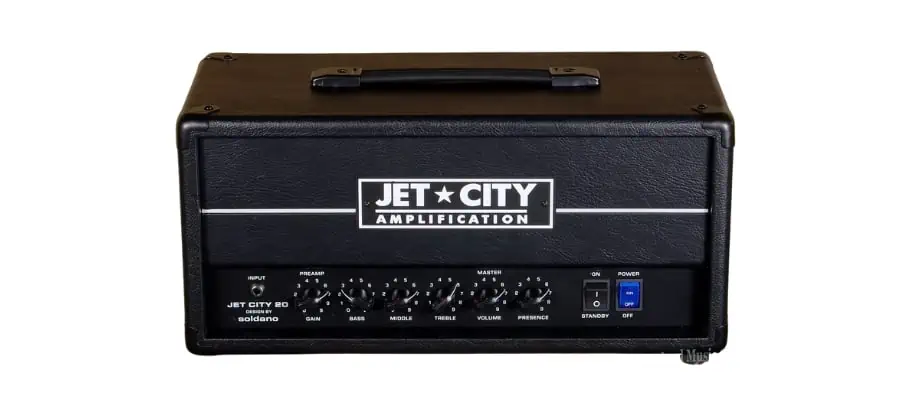

Jet City Amplification JCA20H 20W Tube Guitar Amplifier Head is another amp in the live setup of Joe Perry. He uses it to power a talkbox. To him, this is one of the best talkbox amps ever. He uses the amp in the studio for everything. For drive and clean parts, he likes the sound of this amp.
Marshall JTM45 45W Tube Guitar Amp Head
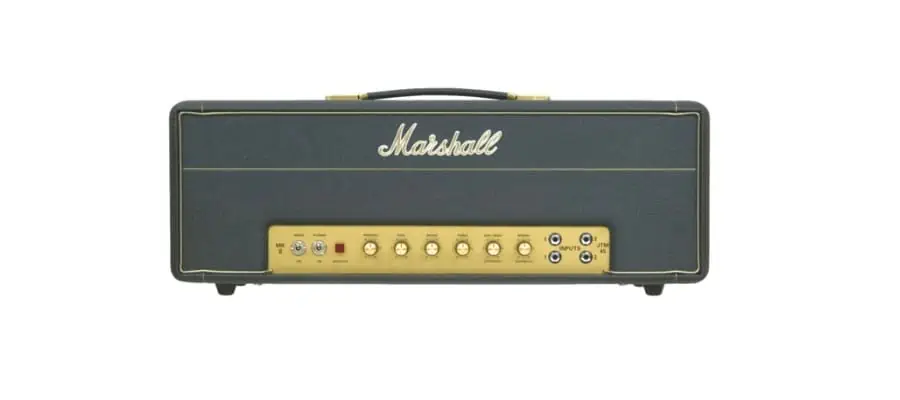

The Marshall JTM45 45W Tube Guitar Amp Head with EL-34 tubes inside is one of the main amps of Joe Perry’s live setup. He has three of these amps—one for the stage and two as the backups.
Marshall Plexi 100W Tube Amp Head
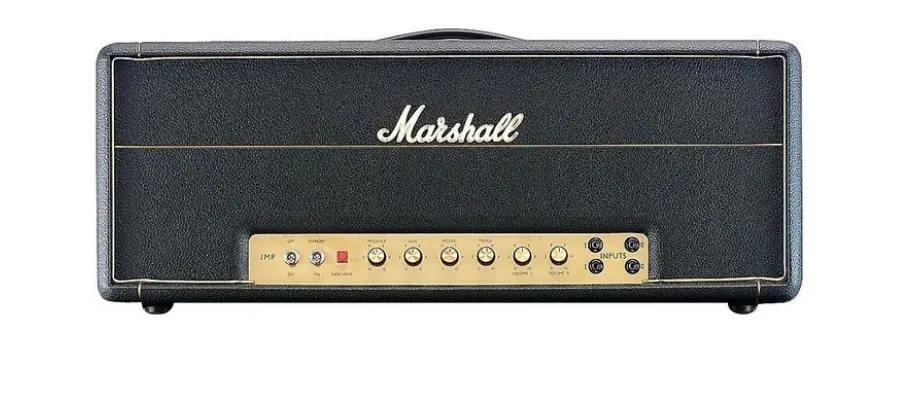

Joe Perry also has two Marshall Plexi 1959SLP 100W Tube Amp Heads. One is the 69, and the other is the 70 version. Sometimes he uses these amps as the main amp instead of the Marshall JTM45 45W Tube Guitar Amp Head.
Marshall Major
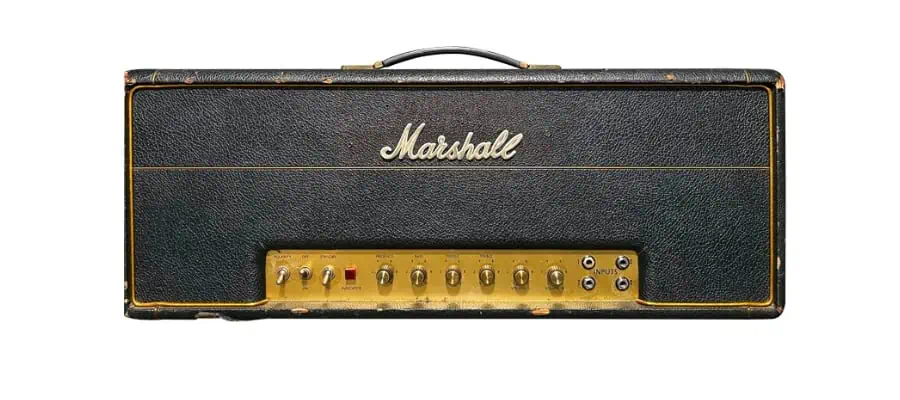

Another amp Perry likes to use on the stage is the Marshall Major. The 200-watt KT-88 tube-driven Marshall Majors are great for the overdriven parts and the leads, as the amp breaks up pretty amazingly.
Budda Verbmaster 1×12″ 80-Watt Tube Combo


Perry used Budda Verbmaster 1×12″ 80-Watt Tube Combo for a few tours during the 2010s. They are custom-made amps.
Morris Mo-Joe Custom Shop Amp


Morris Mo-Joe Custom Shop Amp is another amp from Perry’s arsenal that he uses on the state and in some recordings as well.
Vox AC30 Guitar Combo Amp
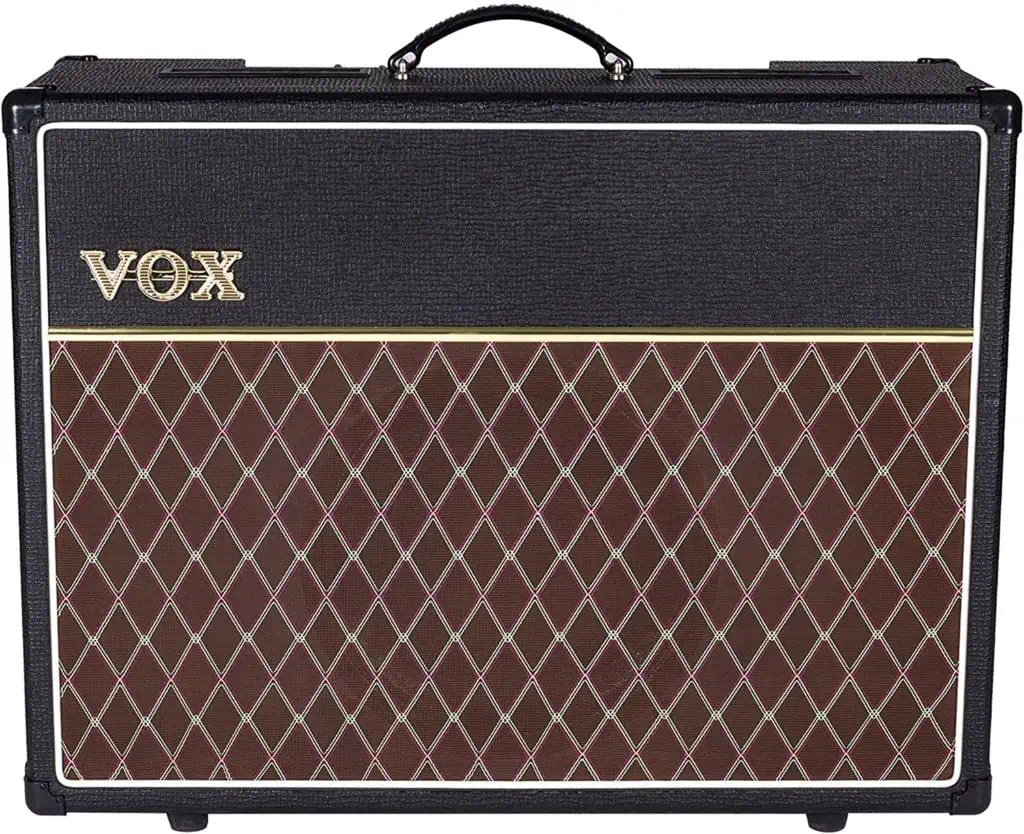
As Perry likes the Vox amps, he also has a Vox AC30 Guitar Combo Amp in his studio for jam sessions, practices, composing sessions as well as recordings.
Fender Twin Reverb
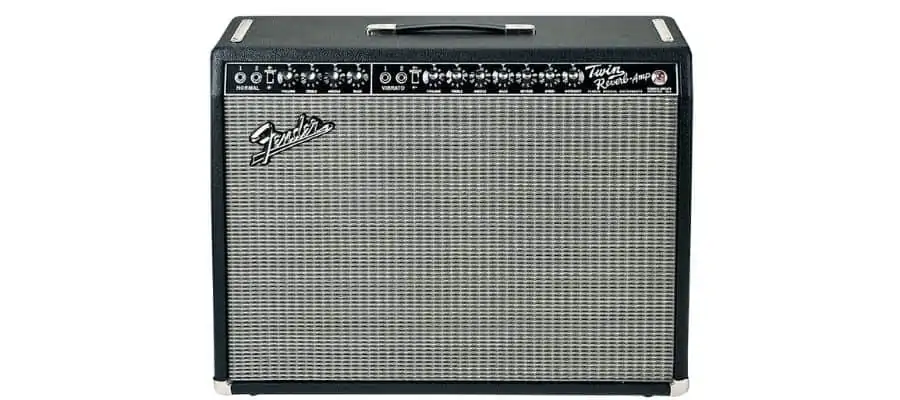
The classic Fender Twin Reverb is another one of Perry’s favorite amps. He mainly uses it in the studio, but also he has one in his live setup for different occasions.
Cabs
Marshall Vintage 8×10 Cabinet
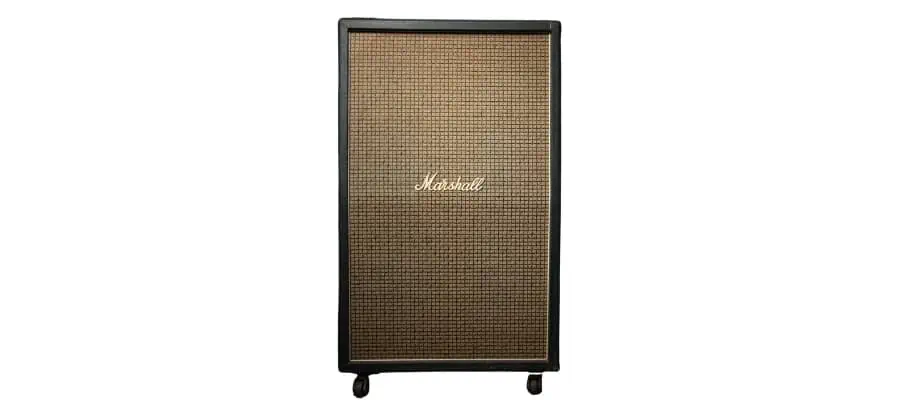

While Perry uses many different cabs, the most regular one of his setup is the Marshall Vintage 8×10 Cabinets.
Microphones
Audio-Technica AT4050 Condenser Microphone
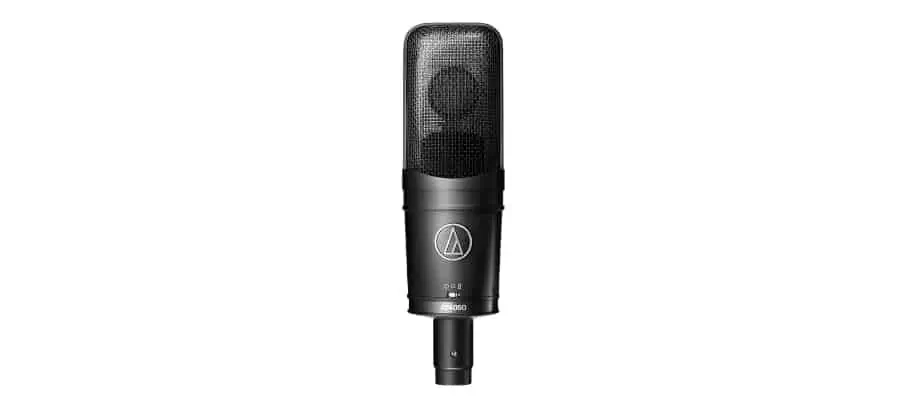
Joe Perry prefers to mic his amps with an Audio-Technica AT4050 Condenser Microphone. He is one of the rare guitarists that use studio mics in front of his cabs.
Shure SM57
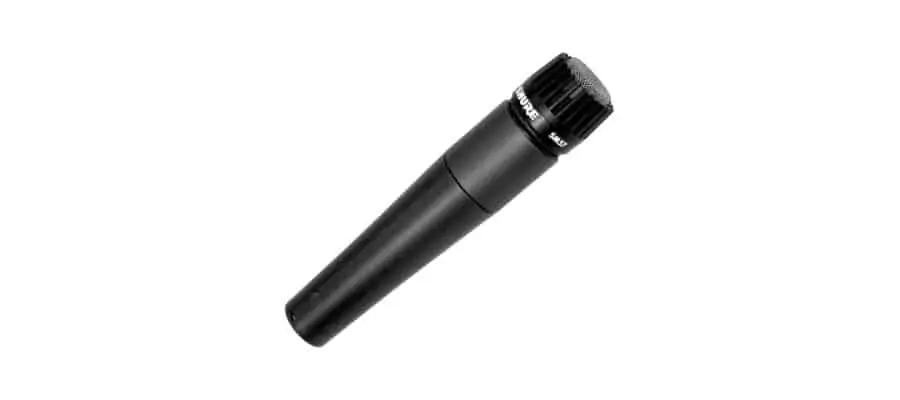
For the Marshall amps, Joe Perry goes with a Shure SM57 mics in front of his amps. He either uses a Shure SM57 or Royer Ribbon mics or both of them in the studio.
Effect Pedals
Klon Centaur Overdrive
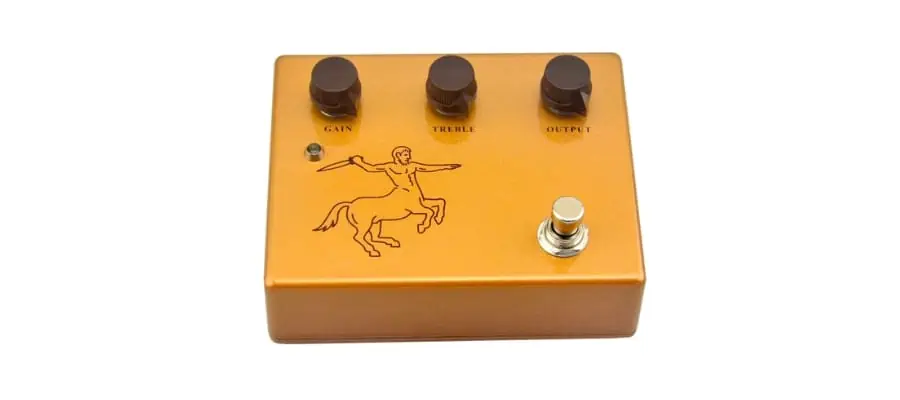
Joe Perry has been using the Klon Centaur Overdrive since the early 2000s. It has been his choice of overdrive pedal since then.

TC Electronic Flashback Delay
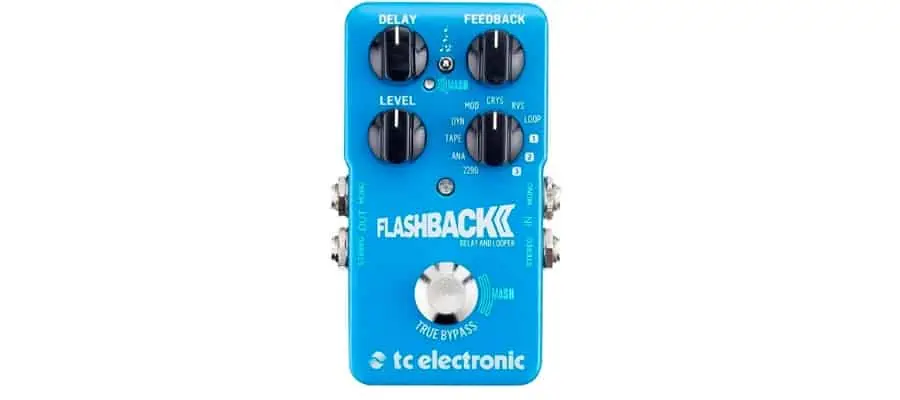
Joe Perry experiments with many different pedals, but the regulars in his setup have always been the TC Electronic pedals since he started using them in the 2000s. TC Electronic Flashback Delay is Perry’s delay pedal of choice.

TC Electronic Vortex Flanger

As Joe Perry likes to use the flanger effect, he always has a flanger pedal in his setup. He tries various flanger pedals, but the most regular member is the TC Electronic Vortex Flanger.

TC Electronic Hall Of Fame Reverb
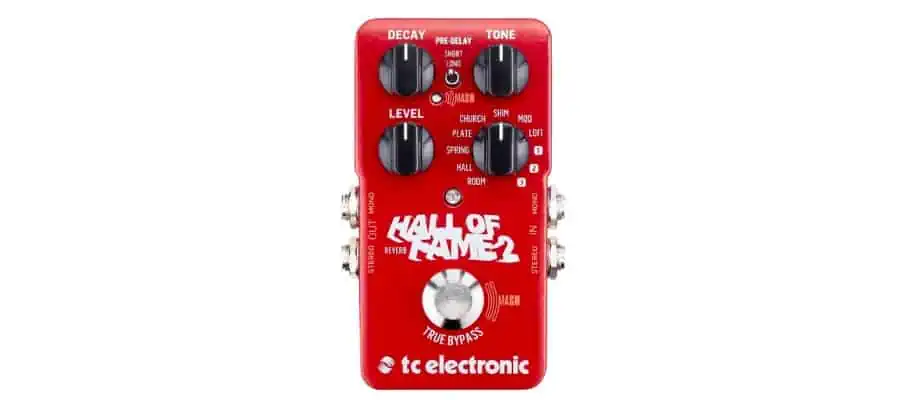
Perry prefers the classic TC Electronic Hall Of Fame Reverb for the reverb effect.

MXR M-108 Ten Band Graphic Equalizer Pedal
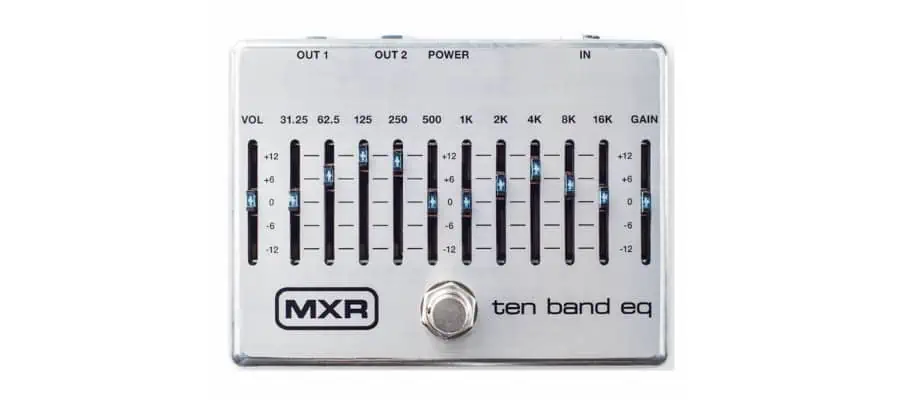
The MXR M-108 Ten Band Graphic Equalizer Pedal is present in Perry’s pedalboard, allowing him to finetune his sound with 10 different frequency bands.

Fulltone OCD Obsessive Compulsive Drive
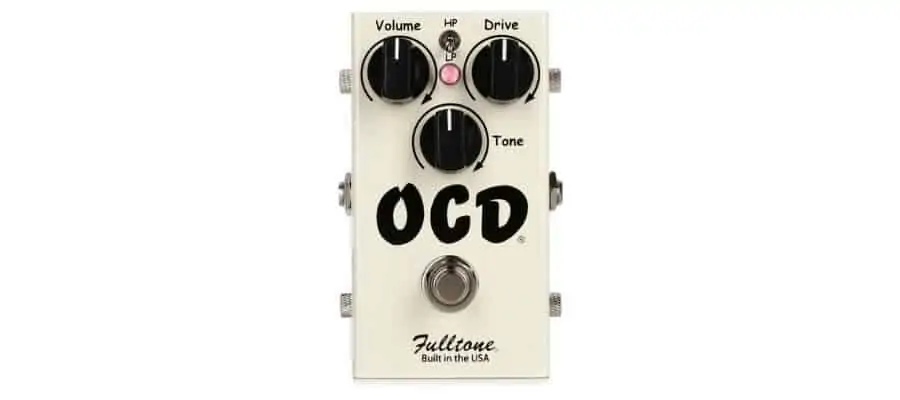
For the extra drive sound, Joe Perry has a Fulltone OCD Obsessive Compulsive Drive in his setup. His guitar tech says it is one of the pedals they are the most satisfied with.

MXR M169 Carbon Copy
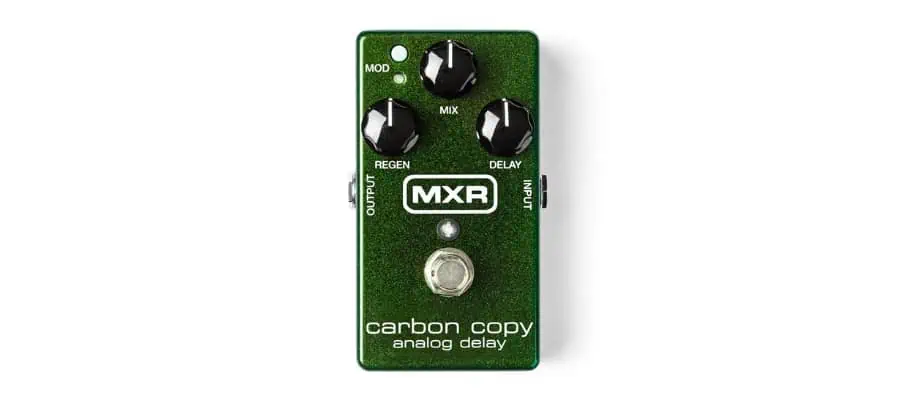
For the quick slap delay effect, Joe Perry also has an MXR M169 Carbon Copy in his live setup.

Duesenberg Gold Boost
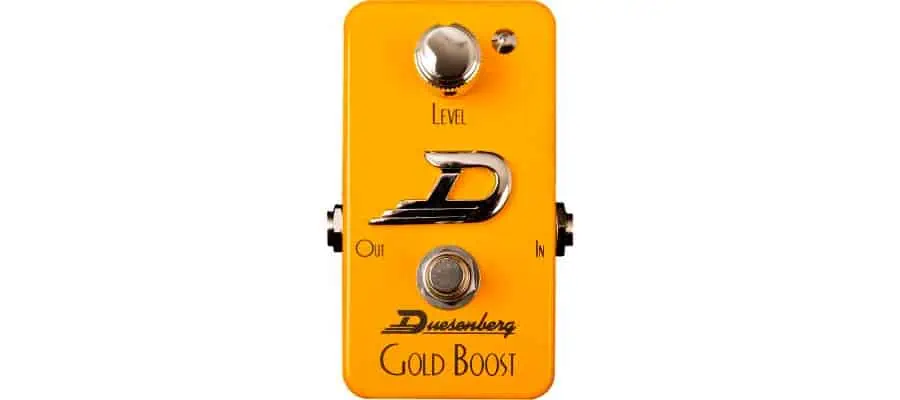
As for the booster pedal, Perry prefers a Duesenberg Gold Boost. Perry likes boosters more than distortion pedals. His actual settings are very clean, but he uses booster pedals to break the amp up.

Boss DD-7 Digital Delay
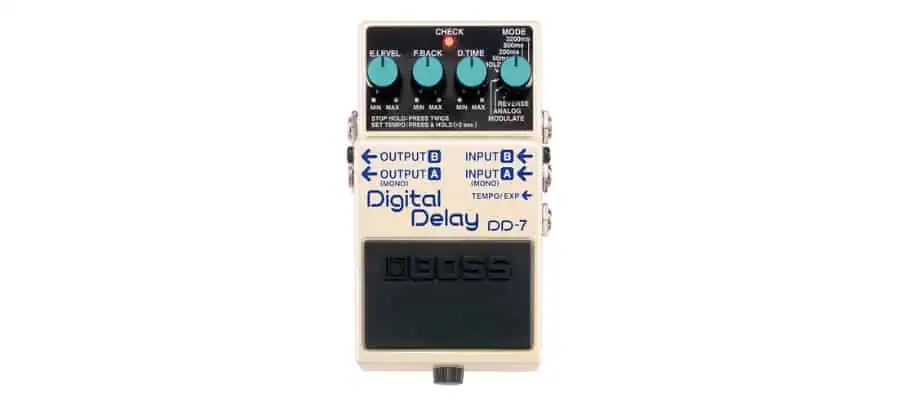
Perry uses the Boss DD-7 Digital Delay for the siren. He likes to turn it on and off from time to time for the siren to carry on.

DigiTech Whammy Pitch-Shifting Pedal
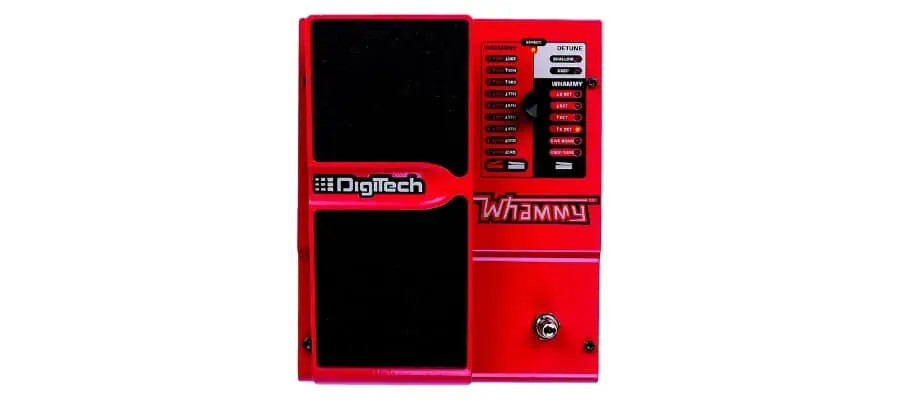
Joe Perry also likes the pitch-shifting effects of the DigiTech Whammy Pitch-Shifting Pedal. He has had one in his setup since the 2000s.

Electro-Harmonix POG Polyphonic Octave Generator
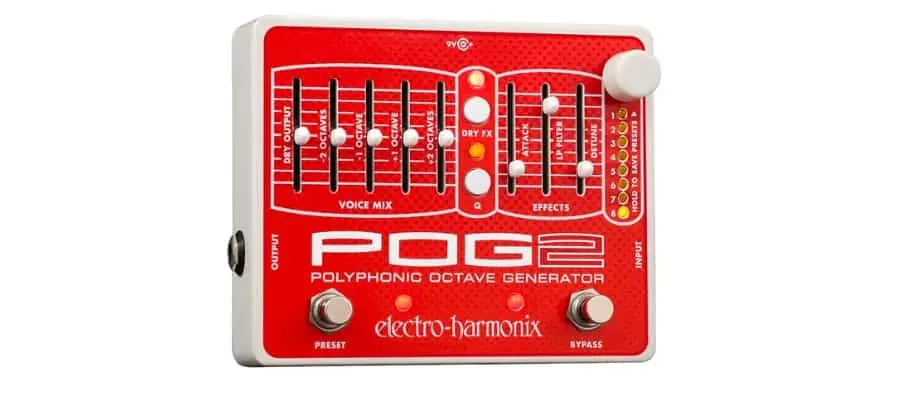
Joe Perry has an Electro-Harmonix POG Polyphonic Octave Generator on his pedalboard, which he uses almost for everything. He likes to create cool effects with the pedal, like the tones you hear in Livin’ On The Edge or Legendary Child.

Option 5 Destination Bump Effects Pedal
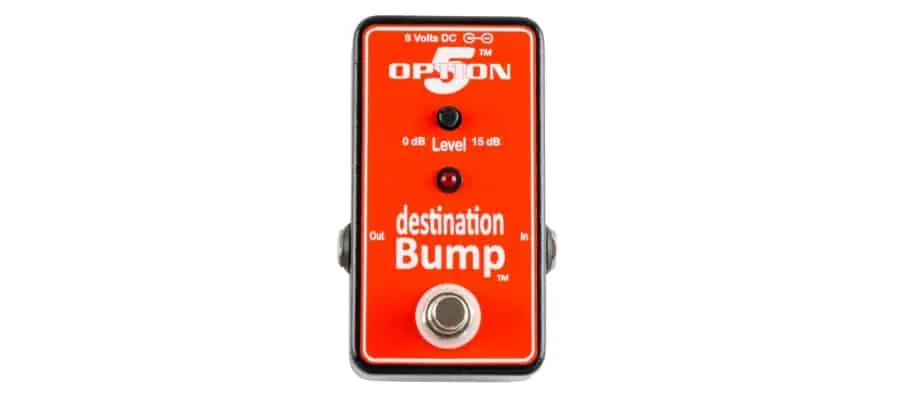
For more boosting effects, Joe Perry also has an Option 5 Destination Bump Effects Pedal, which allows him to boost his tone up to 20 dB.

Dunlop Jimi Hendrix JH-1 Wah Pedal
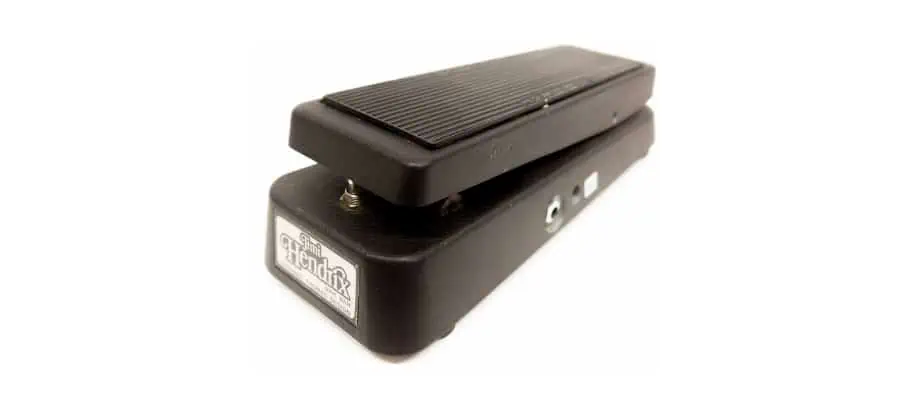
The favorite wah of Joe Perry is the Dunlop Jimi Hendrix JH-1 Wah Pedal. He uses it pretty often.

TC Electronic Ditto Looper
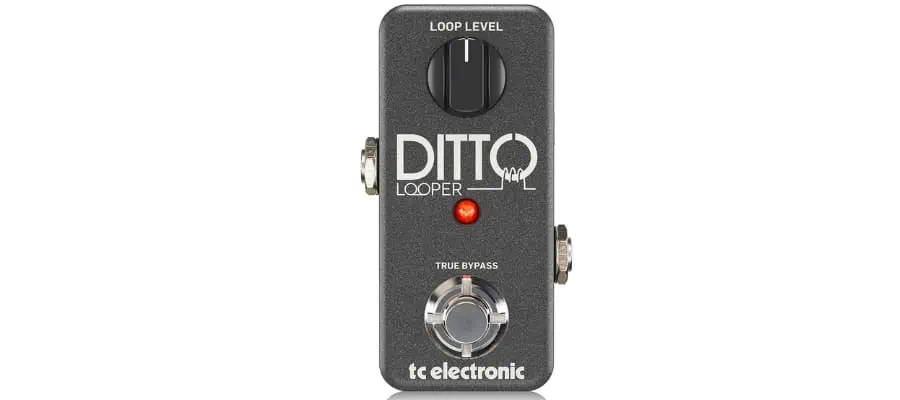
While Joe Perry does not use it on the stage, the official webpage of TC Electronic claims that Perry has TC Electronic Ditto Looper in his studio.

SIB Electronics Mr. Echo Plus Delay
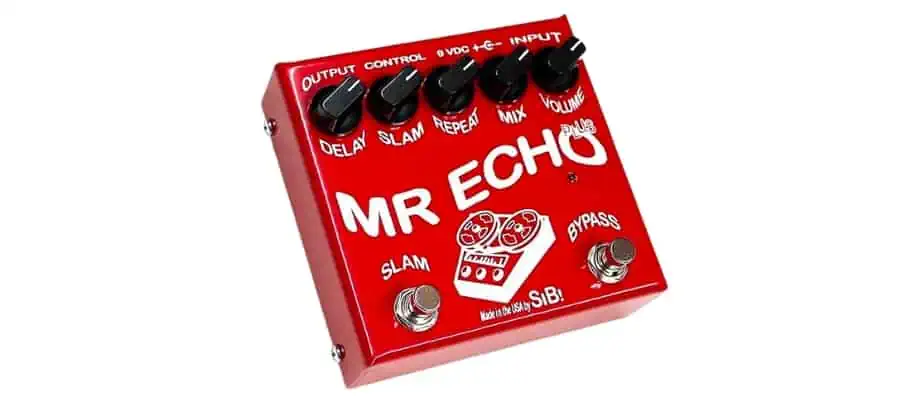
In his recent setups, Joe Perry has two SIB Electronics Mr. Echo Plus Delay pedals on his pedalboard.

TC Electronic PolyTune
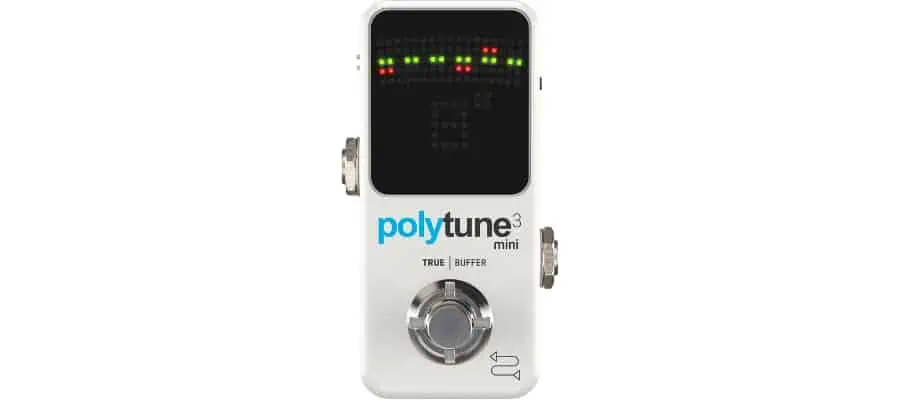
Another TC Electronic pedal Joe Perry has in the studio is the TC Electronic PolyTune.

TC Electronic Corona Chorus
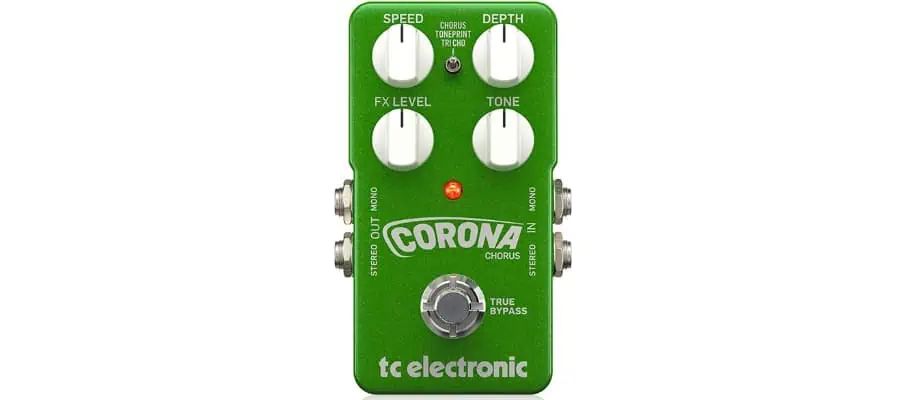
Another studio regular of Joe Perry is the TC Electronic Corona Chorus. He does not use it very often, but when he needs modulation effects, he prefers this one.

TC Electronic Shaker Vibrato
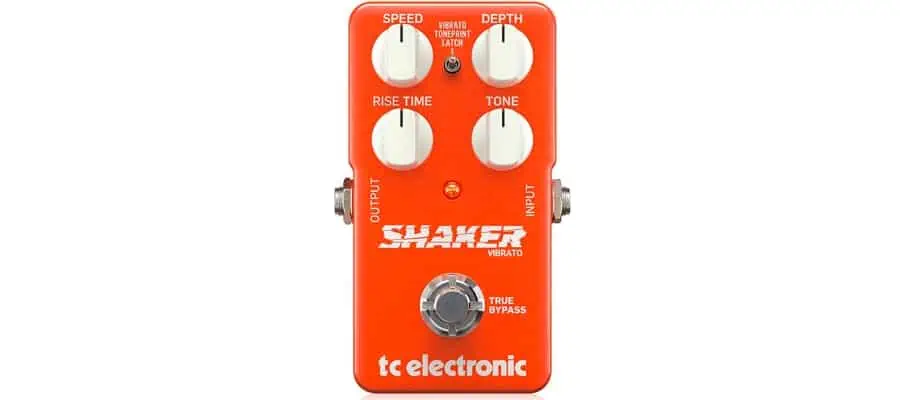
For the vibrato effect, Perry prefers a TC Electronic Shaker Vibrato.

Source Audio SA225 Soundblox 2 Dimension Reverb
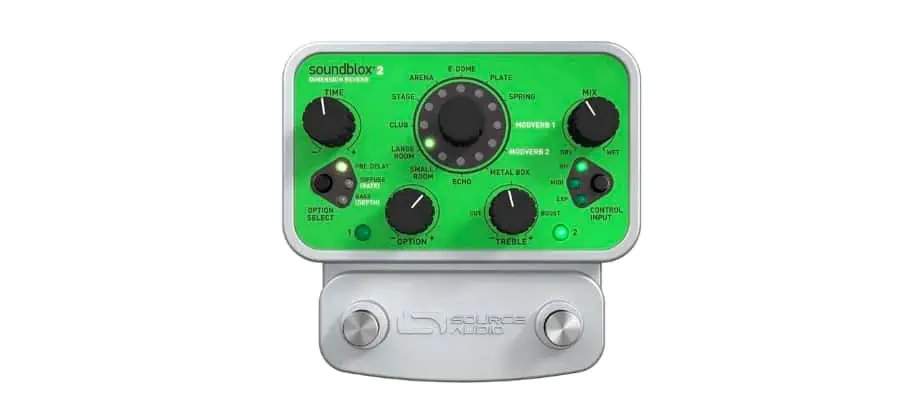
Source Audio SA225 Soundblox 2 Dimension Reverb is another reverb pedal Perry likes to use on the stage. It has two separate reverbs; the first one is a small room, and the second one is a plate reverb with a lot of tail. Perry likes to have a lot of reverb in his tone.

Drybell Vibe Machine V-1
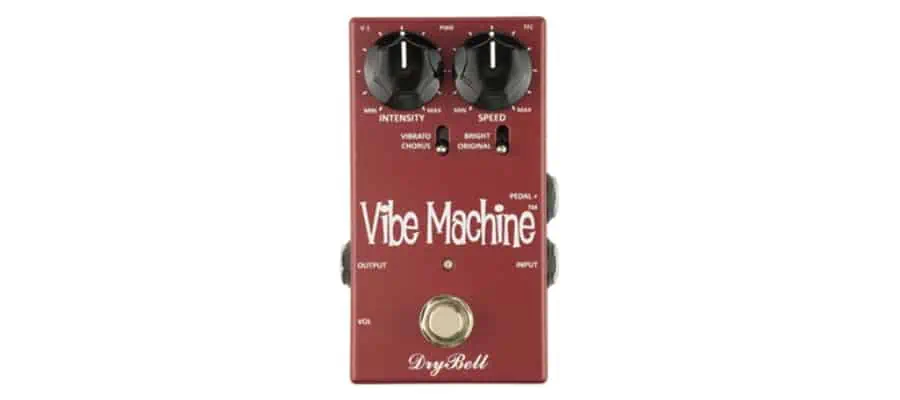
Another vibe pedal Perry likes is the Drybell Vibe Machine V-1, which delivers a very old-school vibe effect.

King Tone Guitar miniFUZZ

Perry also has a King Tone Guitar mini FUZZ in his setup for the fuzz effect. He does not use it often but gets the advantage when he needs some extra aggressiveness in his tone.

Danelectro The Breakdown
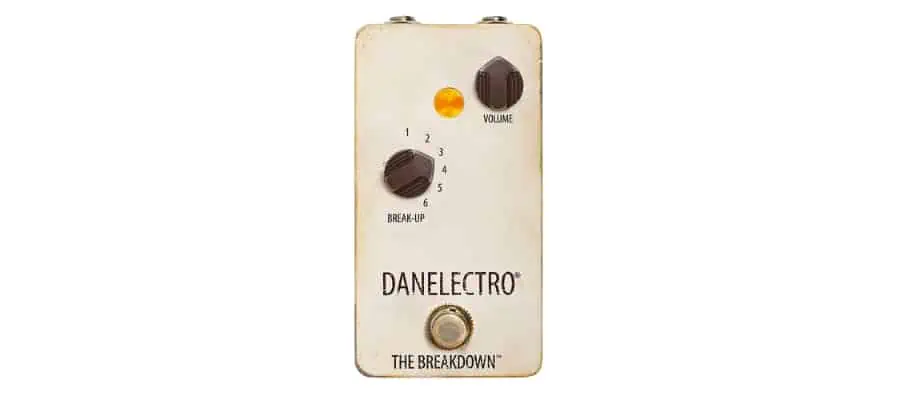
For more Brian May-like tones with a lot of treble, Perry has a Danelectro The Breakdown pedal for the treble boost.

Drybell Unit67
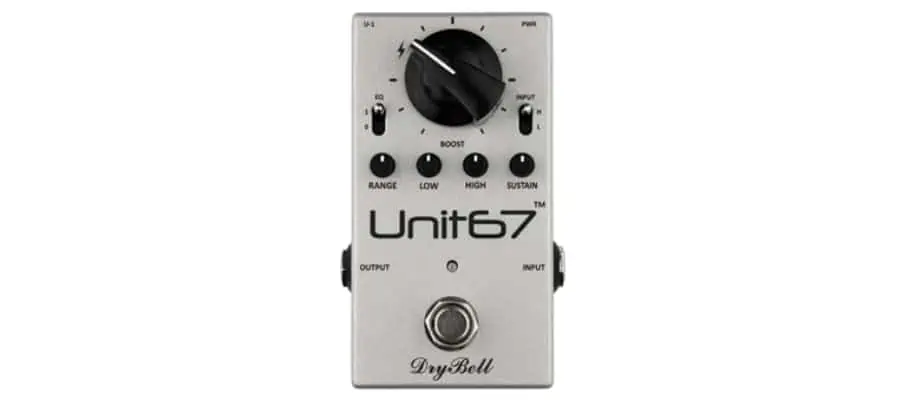
Drybell Unit67 is another member of Perry’s setup. He uses it as a compressor and a booster.

Diamond Tremolo TRM-1
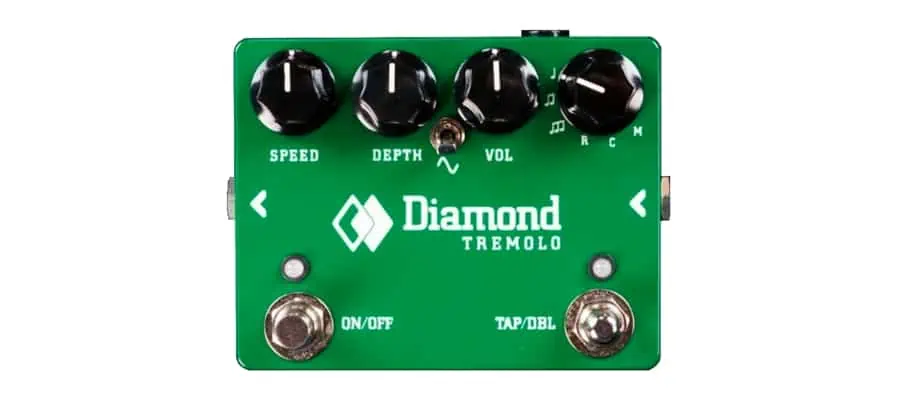
Perry also has a Diamond Tremolo TRM-1 that he occasionally uses for his tremolo effects.

Catalinbread Belle Epoch
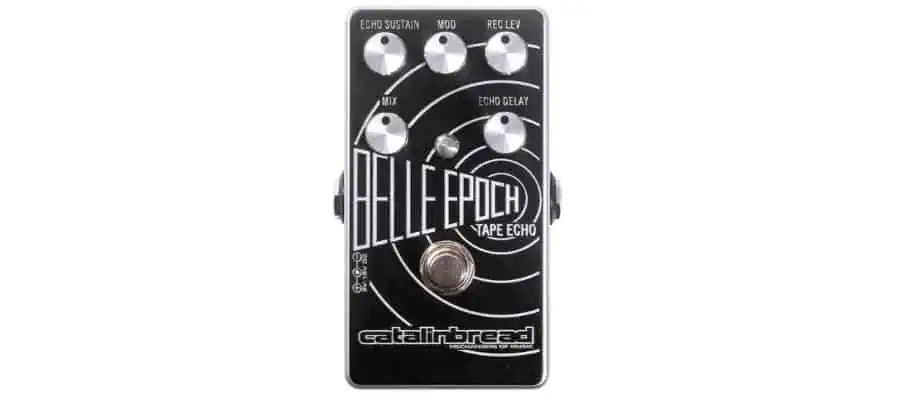
Perry likes the Catalinbread brand line and has some of the models in his studio. Catalinbread Belle Epoch is one of them. The tape echo pedal offers good old-school tape delay.

Catalinbread Katzenkonig
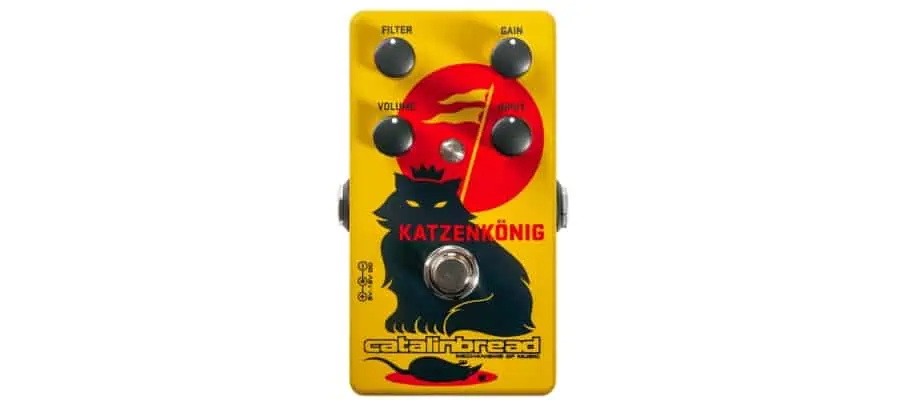
Catalinbread Katzenkonig is the distortion pedal that Perry has in its studio.

Catalinbread Topanga
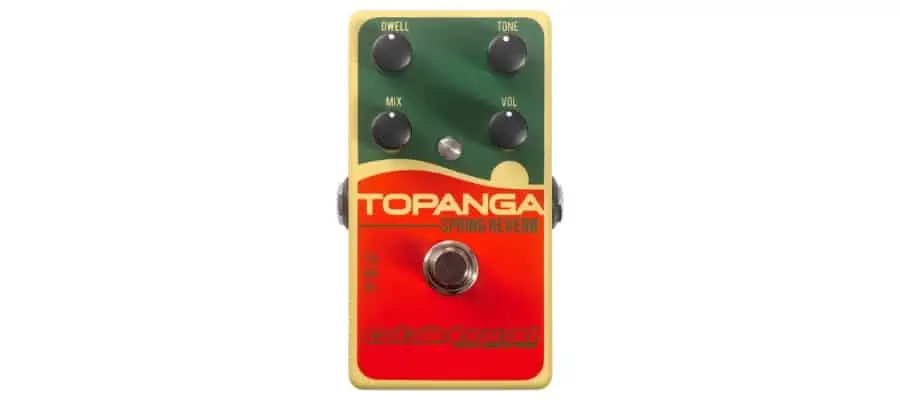
Catalinbread Topanga is another reverb pedal that Perry experiments with within his recordings.

Catalinbread Echorec
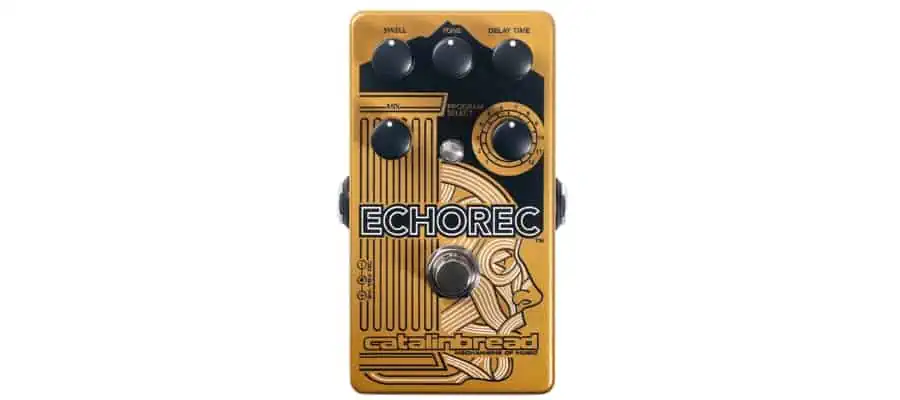
Another delay pedal in Perry’s studio is the Catalinbread Echorec. He likes to have long delays with this one.

Guitar Accessories
Dunlop Joe Perry “Boneyard” Signature Guitar Slide
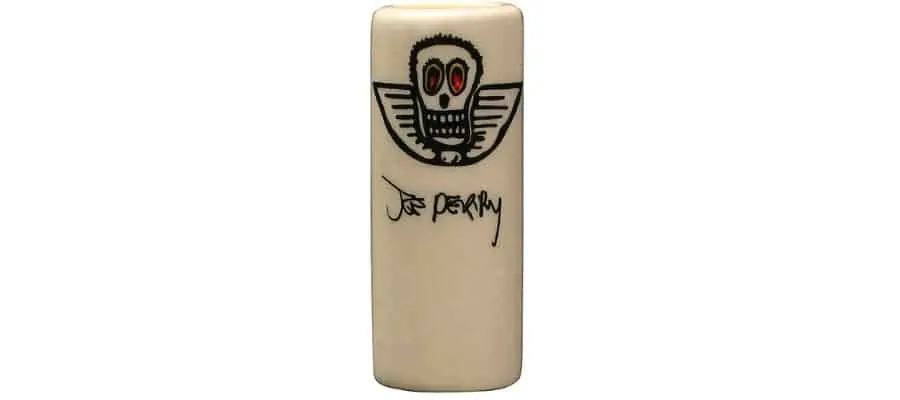
Perry prefers a Dunlop Joe Perry “Boneyard” Signature Guitar Slide for the slide guitar.
Shure ULX-D Digital Wireless System for Guitar/Bass
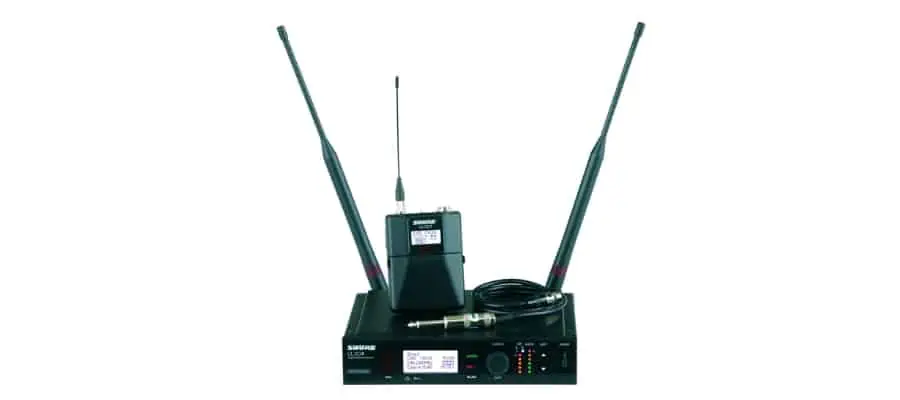
To get rid of the cables, Joe Perry has the Shure ULX-D Digital Wireless System for Guitar/Bass. So he can move freely without the need for any jack cables.
Avid Eleven Rack Guitar Multi Effects Processor and Pro Tools
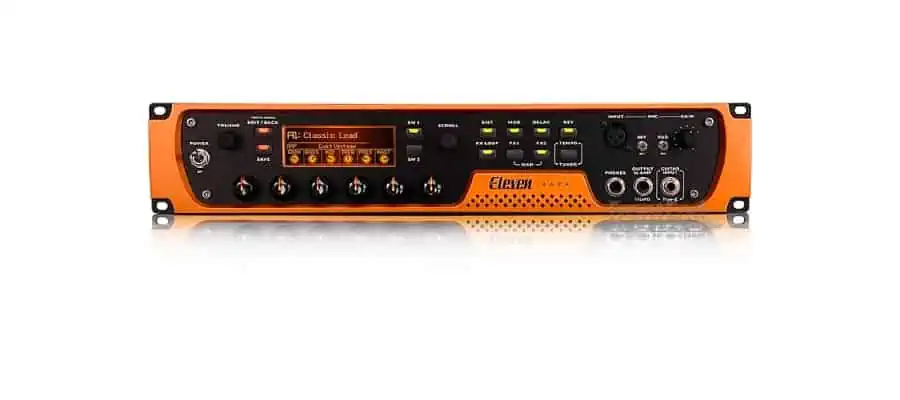
In his studio, Perry uses the Avid Eleven Rack Guitar Multi Effects Processor and Pro Tools to create an unlimited range of effects.
What Is Special About Joe Perry’s Tone?
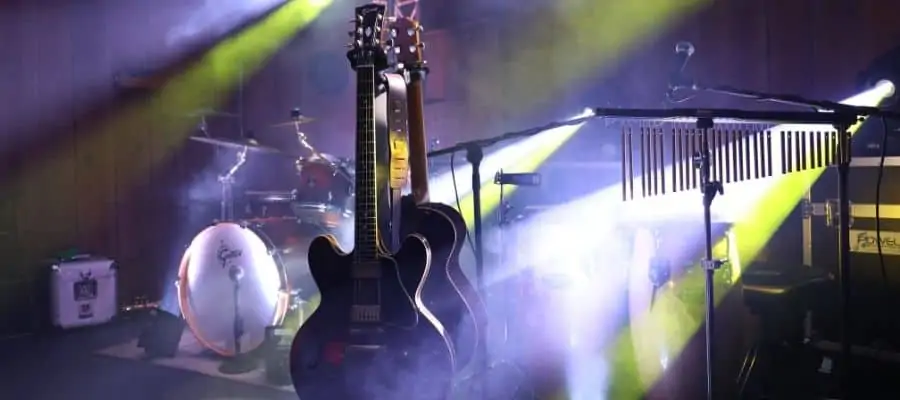
With iconic songs like Dream On, Walk This Way, Pink, Same Old Song, Dance, Sweet Emotion, I Don’t Want to Miss a Thing, and many more, Aerosmith has its name written in rock history with letters of gold. And one of the most important reasons for it is the amazing guitar tones of Joe Perry.
Joe Perry is known for his awesome hard rock guitar tones as well as his versatility as he creates unique tones for each track. His rhythm guitar tracks are rock-solid steel tones, while his solos sound quite fat with a badass attitude. But, he continues creating impressive nuances for every song, like the hypnotic swagger tones in Sweet Emotion or the funky tones in Walk This Way.
Joe Perry’s tone has a distinctive midrange honk as well as a percussive crunch that gives the tone its character.
His tone is quite clean, and he does not rely on distortion or fuzz, as he sounds. He has a clean sound with less gain, as he likes to play clean but loud when the amp starts to break up.
When it comes to his playing style, he is an old-school 70s-style blues-rock lead player with killer hard rock tones. He is one of the most accomplished rhythm guitarists ever, and he is also pretty good with lead guitar. His approach is somewhere between Keith Richards and Leo Nocentelli. He also deploys some funk in his playing, which creates a unique combination, which is not surprising as he is one of the best rhythm guitarists ever.
But, the most important thing about Joe Perry that makes him unique is his confidence and attitude. What he lacks in technique or his tone, as he is never satisfied with his tone, he has them in his attitude. He is a true rock star and is one of the best composers of his time.
How To Sound Like Joe Perry?
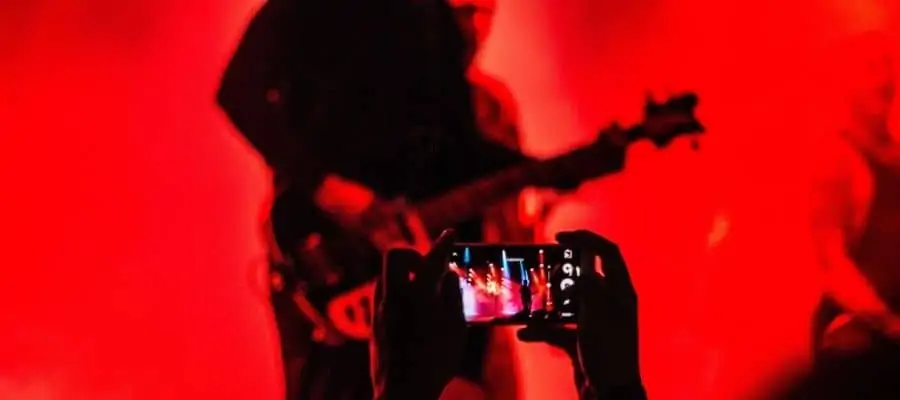
If you want to sound like Joe Perry, first, you have to decide which Joe Perry tone you want to achieve. Because he creates unique characters for each song, emphasizing a different part of his tonal range in different songs. In general, he has a killer hard rock tone with good hints of funk, blues, and classic rock.
Starting with the guitar, Perry is known for playing as many as 14 guitars in one concert. But his main choice has been the Les Pauls since the 80s. For the amp choice, he likes to have hot Ampegs as he used them in the first years of his career. But, later, he switched to Marshalls and Fenders. So, any hot tube amp can get you pretty close to his tone with the right settings.
So, put the gain to a low setting in the tube amp, around 3 to 5, and turn up the volume until the amp starts to break up and get to overdrive ranges. This is the sweet spot of Joe Perry. For lead tones, you can use a booster pedal to even go to more distortion ranges, or you can have an overdrive pedal to help you. If you have a solid-state amp, try to turn up the gain a bit more to around 5 to 6.
The EQ settings will highly depend on the guitar-amp combination as well as the song you want to play. But, the basic Joe Perry tone should have the bass around 4 to 5, the mids around 4 to 6, and the highs around 5 to 7. Depending on the song and your pickups and amp, you can start playing with the EQ from these points.
Things get a bit complicated when it comes to effects, as Joe Perry uses around 20 pedals in every show. But the fundamental pedals you need are the booster, overdrive, reverb, compressor, and flanger pedals.
Try to add a bit of reverb to your tone, but not much like the slight reverb around 2 or 3 o’clock would be perfect. You can try out the compressor to increase the sustain and make the tone smoother, while the booster or overdrive pedal should be ready for the lead guitar partitions to make your tone stand out and get you more gain when needed. Finally, flanger would be a great addition to the tones in songs like Walk This Way.
You can get close to the Joe Perry tone with these settings and pedals. But, to play like him, you must also get his technique and approach. He likes to play 7th, 9th, and Sus chords and double stops, as well as the traditional rock power chords and inversions. He likes to deploy syncopations and swinging 16th note rhythms, which give the real character to Aerosmith spirit. He also likes to get funky with licks up and stabs.
For the lead guitar parts, he likes to play the pentatonic scales either in minor or major. He also plays Mixolydian modes pretty often when soloing as well as when rhythm playing. He phrases on the upbeat and plays around the beat using syncopations, just like Jeff Beck. His solos mainly stem from the song riffs, another very-Joe-Perry-style move.
And finally, to play like Joe Perry, you need to have confidence which is the most important aspect. Although he is close, he is not the technically most skilled player, and he does not have the greatest tone ever. Still, what he lacks in these areas he completes with his songwriting, his attitude, and his confidence, as he has a badass character and gives some of the best shows of rock music.
Joe Perry Guitar Rig Examples
Budget
Guitar – Epiphone Les Paul Studio E1
- Mahogany body
- Zebra Coil Humbuckers
- Tapered neck joint for easy upper fret access fast playing
- Classic Les Paul with Carved Top
Amp – Boss Katana 50 MkII
- Stage-ready 50-watt combo amp with a custom12-inch speaker
- Tube Logic design approach produces class-defying power, authoritative...
- Five unique amp characters(Clean, Crunch, Lead, Brown, and Acoustic),...
- Five independent effects sections(Booster, Mod, FX, Delay, and Reverb),...
If you want to have a tone close to Joe Perry without breaking the bank, you can go with a basic Les Paul style guitar like an Epiphone Les Paul Studio E1, along with a good modeling amp such as Boss Katana 50 MkII. This way, you can kind of get closer to his tone and his versatility with the right settings.
Mid-Range
Guitar – Epiphone Les Paul Standard ’60s Electric Guitar
- AA Flame Maple Top
- Mahogany Body & Neck
- Indian Laurel Fingerboard w/ Pearloid Trapezoid Inlays
- ProBucker Pickups
Amp – Vox AC15
- Classic British tube amp with 10 watts of power for rich, authentic tones
- Equipped with EL84 power tubes and 12AX7 preamp tubes for classic VOX sound
- Custom 10" Celestion VX10 speaker for powerful, clear sound projection
- Features both normal and Top Boost channels for versatile tone shaping
Effect Pedal – Klon Centaur Overdrive
Effect Pedal – TC Electronic Hall Of Fame Reverb
- New MASH footswitch and shimmer effect
- Tone print- instant access to custom pedal-tweaks made by your idols!
- Stereo in & out - added flexibility to fit any set-up
- True bypass - Zero loss of tone
Effect Pedal – TC Electronic Vortex Flanger
- Tone print technology Enabled
- Classic flange and tape flange modes
- Intuitive yet deep control set
- TonePrint- instant access to custom pedal-tweaks made by your idols!
It is easier to reach Joe Perry-style tones for mid-range budgets, at least some of them. You can go with a good Les Paul-style guitar like an Epiphone Les Paul Standard ’60s Electric Guitar, along with a Vox AC15, which Joe Perry uses in his studio. You can go with his regulars like Klon Centaur Overdrive, TC Electronic Hall Of Fame Reverb, and TC Electronic Vortex Flanger for the effects. Depending on the song, you can use some of the effect pedals and add new ones for various tones.
High-End
Guitar – 1996 Gibson Custom Shop Joe Perry Les Paul
Amp – Marshall 1987XL Bundle – Head and 1960A Cabinet Bundle
- Bundle with Marshall 1987X Plexi Amp Head and 1960A 4x12" Cabinet
- 1987X 50-watt Plexi Tube Head with FX Loop: 50-watt Vintage Series...
- 1960A 300-watt 4x12" Angled Extension Cabinet: 300-watt, 4/8/16-ohm, 4x12"...
Effect Pedal – TC Electronic Vortex Flanger
- Tone print technology Enabled
- Classic flange and tape flange modes
- Intuitive yet deep control set
- TonePrint- instant access to custom pedal-tweaks made by your idols!
Effect Pedal – TC Electronic Flashback Delay
- Flashback 2 delay effects pedal.
- The tc electronic flashback 2 delay packs the company's entire delay legacy...
- TC Electronic groundbreaking MASH technology adds an expression pedal to a...
- Package Weight: 0.431 kilograms
Effect Pedal – MXR M169 Carbon Copy
- Rich, all-analog delay
- Up to 600 milliseconds of delay time
- Modulation controls emulate tape echo tones
- Bucket-brigade technology
Effect Pedal – TC Electronic Hall Of Fame Reverb
- New MASH footswitch and shimmer effect
- Tone print- instant access to custom pedal-tweaks made by your idols!
- Stereo in & out - added flexibility to fit any set-up
- True bypass - Zero loss of tone
Effect Pedal – Duesenberg Gold Boost
Effect Pedal – Option 5 Destination Bump Effects Pedal
Effect Pedal – Klon Centaur Overdrive
If you have a large budget, you can basically replicate one of Joe Perry’s live setups to get the exact tones he uses. For that, you should have his exact guitar, a 1996 Gibson Custom Shop Joe Perry Les Paul, along with his exact amp, Marshall 1987XL Bundle – Head and 1960A Cabinet Bundle. He uses many different guitars and many different amps, but these ones are some of the most regular members of his live concerts.
For the effects side, you should go with his TC Electronic-heavy setup. So to get his versatility, you should at least get these pedals and build your tone according to the song you are playing.
Conclusion
Joe Perry is one of the most influential and unique guitarists in rock history. He likes to experiment with different gear and use many different effects to build his tone. So, it is not easy to replicate his exact sound, but with the right gear, you can get pretty close.
The examples in the article on Joe Perry’s gear, effects, tone, and rigs are not the whole story, as the article would be much longer if I tried to list all the gear he used in his career. I tried to stay loyal to his most famous and recent gear when writing the article. From the early days of his career with his DIY setups in the early 70s to his complex and high-end setups in recent years and all Aerosmith shows, he is one of the guitarists who has perfected the guitar tones. He will always be mentioned as one of the leading greats when it comes to modern guitar effects and tones.
If you found this article useful, you may want to save this pin below to your Guitar board.
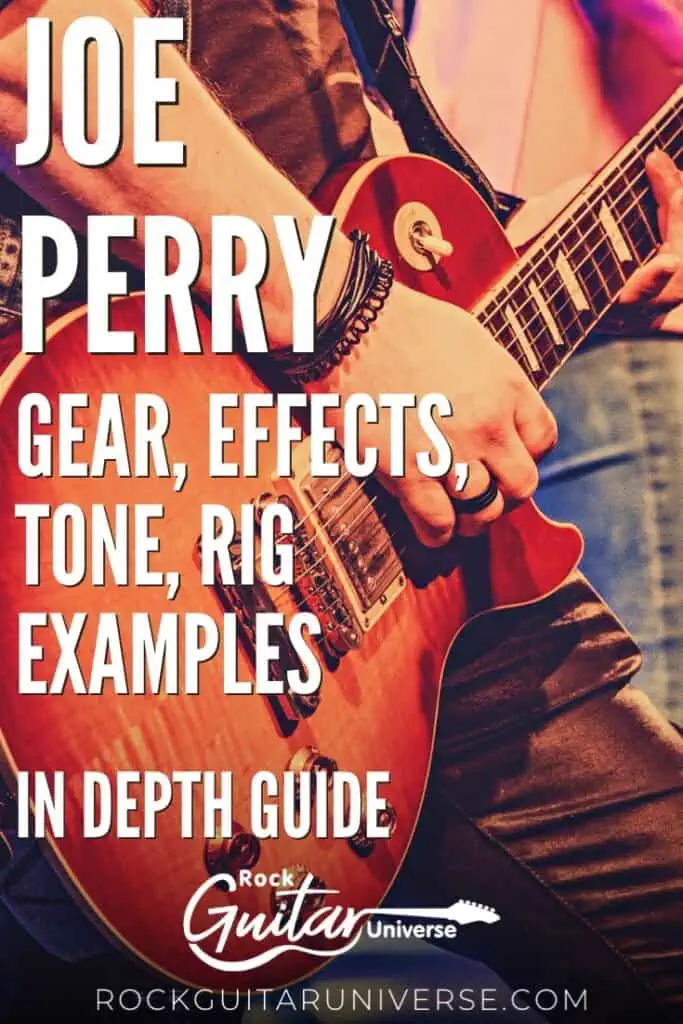
Last update on 2025-12-22 / Affiliate links / Images from Amazon Product Advertising API
Recent Posts
When learning new songs have you noticed that some of the chord sequences sound really good? But when you tried to come up with your own chord sequence, or as we call it chord progression, you found...
Some guitarists insist on buying an expensive amplifier with their electric guitar. They assume that this is a must for every type of guitarist out there. However, in some situations, this isn’t...

